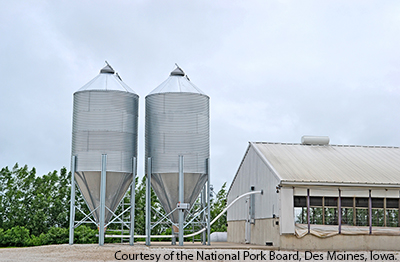Contingency planning for feed: expecting the unexpected
11/12/24
 AMES, Iowa – An out-of-feed event on a farm can cause major problems in just a short amount of time. Having a back up plan can allow for feed to be manufactured, delivered, and placed in feeders in a timely manner during times of crisis while the producer continues to run an operation like normal.
AMES, Iowa – An out-of-feed event on a farm can cause major problems in just a short amount of time. Having a back up plan can allow for feed to be manufactured, delivered, and placed in feeders in a timely manner during times of crisis while the producer continues to run an operation like normal.
A new publication from Iowa Pork Industry Center, Contingency Planning: Feed, explains potential feed supply interruptions and management considerations for developing contingency plans. Iowa State University extension swine specialist Mark Storlie authored the publication, and said daily feed supply is important for the growth and general well-being of sows, piglets, and market pigs.
“Unexpected incidents can derail your plan to have a timely feed supply,” be said. “While some incidents are unforeseeable, all events can be minimized through contingency planning.”
Several different factors serve as potential interruptions to an operation. Severe weather, feed mill troubles, human error, federal regulation, and equipment malfunction can be easy to push to the side until they adversely affect the farm.
Understanding how much feed is being consumed daily in each barn is an important step while creating a plan. This allows for accurate feed ordering and planning. Growing pigs typically consume 4-6% of their body weight daily, and producers can use feed budgeting software along with charts that demonstrate estimated feed consumption.
Storlie said producers should strive to maintain 72 hours of feed inventory. Here are three strategies to combat uncontrollable circumstances:
- Keep inventory of backup equipment or parts.
- Establish a relationship with secondary or a back up feed mill.
- Identify how to stretch existing feed inventory and what ingredients are readily available.
“Tandem bins - two bins for each group of pigs - is the ideal scenario. When one bin runs empty, the caretaker switches to the second bin and can place an order for the next feed delivery,” he said. “Your contingency plan describes how your team should react if something interrupts the normal course of business.”
Contingency plans can help provide 72 hours of feed inventory at all times, which can allow for wiggle room and ensure pigs stay healthy during an out-of-feed event. A contingency plan establishes a plan of action to save time and money, decrease recovery time, and reduce stress on people, pigs, and equipment. These factors are important things to plan for when establishing an operation and can be helpful in the long run.
The publication IPIC 208A is available at no charge from the ISU Extension store.
This article was written by IPIC student communications assistant Lauren Beyer.
-30-
IPIC was established in 1994 as a coordinated effort of the colleges of Agriculture (now Agriculture and Life Sciences) and Veterinary Medicine at ISU. Its mission is to promote efficient pork production technologies in Iowa, maintain Iowa's pork industry leadership and strengthen rural development efforts. IPIC focuses its efforts on programs that are integral and complementary to ISU Extension and Outreach. Through IPIC, Iowa producers receive accurate and timely information to make their operations more efficient and profitable.
